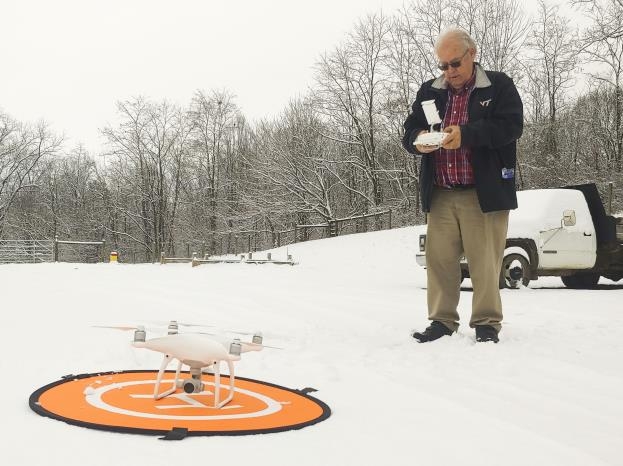Drone Use in the Winter
ID
SPES-186NP
Introduction
As the use of drones in agriculture has become more widespread, farmers are becoming more aware of their limitations, especially during the winter. First, cold weather negatively affects flight times and drone reliability. Furthermore, cold weather affects human dexterity, which influences the pilot’s ability to operate the drone. As a result, drones are often relegated to storage during the winter until warmer springtime temperatures arrive. Here are some tips to keep drones flying during the winter months.
Dry drones operate more efficiently than wet drones
In addition to the standard preflight checks, additional precautions should be taken to prevent damage to drones when flying in adverse winter or wet conditions. Simply put, moisture destroys drone motors.
- Avoid flying when it is snowing or raining.
- If necessary, dry the props to reduce the incidence of moisture contact with motors.
- Use a landing pad to reduce contact with moisture during takeoff and landing (figure 1).
Drone batteries drain more quickly in the cold
Following a few measures can reduce the effects of cold weather on drone batteries.
- Always check batteries before flying.
- Charge batteries to 100% within 24 hours before flying.
- Always put warm batteries into the drone. Batteries can be kept warm by keeping them in a warm vehicle or by using commercially available battery warmers. Hand warmers can also be used, but never place hand warmers directly on batteries. Instead, wrap the batteries in some type of cloth and, using gloves, hold the warmer close to the batteries.
- Install batteries in drones immediately prior to flying.
- When possible, keep the drones in a warm vehicle until usage.

Maximizing battery life while flying
Taking these steps will maximize drone flight time during cold weather.
- Use manual takeoff, and allow the drone to warm up on the ground at least 30 seconds prior to taking off.
- Allow the drone to hover for a while (30-60 seconds) after takeoff.
- Do not use full throttle during flight operations. Flying at full throttle will drain the battery quicker and reduce flight time faster.
- If possible, fly at a lower altitude to accomplish the work to be done.
- Check the battery charge level constantly while flying. Remember, batteries drain faster in cold weather.
- Keep batteries fully charged on tablets, phones, and controllers. It’s a good idea to use a portable power bank to keep these devices charged.
- To avoid getting moisture into the drone, do not fly into clouds.
- The use of tight-fitting gloves with touch screen capability is recommended when operating the controller and using tablet/phones.
Summary
Flying a drone on the farm in winter can be challenging. However, taking a few simple precautions can reduce challenges and maximize the use and enjoyment of this important technology.
References
Cooke, Alex. 2016. “Ten Tips for Flying a Drone in Winter and Capturing Great Photos.” Fstoppers Original. https://fstoppers.com/aerial/ten-tips-flying-drone-winter-and-capturing-great-photos-157650.
DJI. 2017. “Flying a Drone in Winter: 5 Things You Must Know.” DJI Guides. https://store.dji.com/guides/winter-drone-flying-tips/
Federal Aviation Administration. 2018. Part 107 UAS Regulations. Commercial Operations Branch.
Virginia Cooperative Extension materials are available for public use, reprint, or citation without further permission, provided the use includes credit to the author and to Virginia Cooperative Extension, Virginia Tech, and Virginia State University.
Virginia Cooperative Extension is a partnership of Virginia Tech, Virginia State University, the U.S. Department of Agriculture (USDA), and local governments, and is an equal opportunity employer. For the full non-discrimination statement, please visit ext.vt.edu/accessibility.
Publication Date
November 2, 2020



